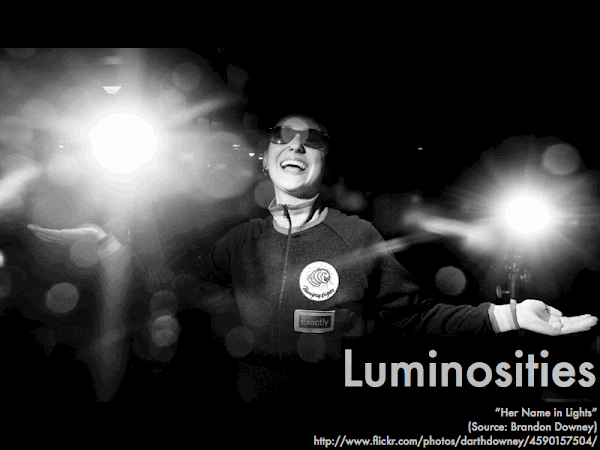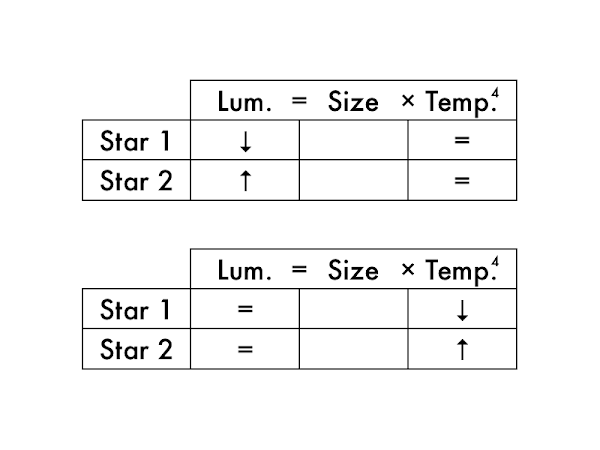Cuesta College, San Luis Obispo, CA
Students have a weekly online reading assignment (hosted by SurveyMonkey.com), where they answer questions based on reading their textbook, material covered in previous lectures, opinion questions, and/or asking (anonymous) questions or making (anonymous) comments. Full credit is given for completing the online reading assignment before next week's lecture, regardless if whether their answers are correct/incorrect. Selected results/questions/comments are addressed by the instructor at the start of the following lecture.
The following questions were asked on reading textbook chapters and previewing presentations on parallax, distance, apparent magnitude, absolute magnitude, Wien's law and the Stefan-Boltzmann law.

Selected/edited responses are given below.
Describe something you found interesting from the assigned textbook reading or presentation preview, and explain why this was personally interesting for you.
"that the hotter the stars are the bluer in color they appear. This is interesting to me because I always thought as red to be the hotter color and not blue."
"Reading about the motion of particles and how that pertains to how an object glows; or how an opaque object gives off of a blackbody radiation. I initially wasn't thinking objects would glow or radiate due to their particle motion, but once reading about particle motion and the wavelengths that come off from them I understood a lot more about blackbody radiation."
"The way that that they rank the stars brightnesses--that the more negative the rank the brighter the star.""
"That the stars can have the same temp but the bigger one will have a bigger luminosity."
"The perspective of how the sun to us is so bright but compared to other bright stars it may not be so bright."
Describe something you found confusing from the assigned textbook reading or presentation preview, and explain why this was personally confusing for you.
"I'm confused on the Stefan-Boltzmann law, because I don't fully understand how to use it."
"The colors of heat."
"I don't quite understand the difference between a large parallax and a small parallax. I understand that its purpose is to measure distances of stars, because due to their brightness and our perspective, things don't appear as they seem. Some stars are brighter than others."
"Why do they use positive numbers to describe dim stars and negative high numbers to describe bright stars? So confusing."
"I'm confused about which star is hotter between a white dwarf and a yellow supergiant. Wouldn't they be tied?"
"It's confusing that two stars can be equal in brightness, but different in temperature."
"The temperature scale is a little challenging. My brain thinks of blue as being cooler but for stars it is hotter."
"I have no idea how the Stefan-Boltzmann law works."
"I don't quite understand the way parallax is used to measure distances between stars."
Explain how apparent magnitude and the absolute magnitude are defined differently.
"Apparent magnitude is how bright is from Earth's view, absolute magnitude is if it were placed at 10 parsecs from earth how bright it would be."
"The apparent magnitude of a star is the amount of brightness as is seen from an observer on Earth. Because the sun is right next to us, we assume that its brightness is greater than that of another star that is billions of light years away, and is seen in our night sky. Absolute magnitude is when we relocate the stars to 10 parsecs away and see the 'actual' brightness of stars. So we would move both our sun and the distant star to 10 parsecs. Then judging their brightness would be fair."
"Apparent magnitude is what it looks like, while absolute magnitude is what it is."
Suppose the sun was moved to a distance of 10 parsecs away. As a result, its __________ magnitude would become dimmer.
absolute. ****************** [18] apparent. ********************* [21] (Both of the above choices.) ***** [5] (Neither of the above choices.) * [1] (Unsure/guessing/lost/help!) * [1]

(Only correct responses shown.)
1 (brightest): the sun, m = –27 [89%]
2: Canopus, m = –1 [83%]
3: Vega, m = 0 [78%]
4 (dimmest): Kapteyn's star, m = +9 [80%]
Rank the brightnesses of these stars (1 = brightest, 4 = dimmest; there are no ties), if relocated to 10 parsecs from Earth.
(Only correct responses shown.)
1 (brightest): Canopus, M = –3 [70%]
2: Vega, M = +0.5 [76%]
3: the sun, M = +5 [67%]
4 (dimmest): Kapteyn's star, M = +11 [70%]
Determine whether these stars get dimmer or brighter when relocated from their original positions to 10 parsecs from Earth.
(Only correct responses shown.)
The sun: gets dimmer [80%]
Canopus: gets brighter [61%]
Vega: gets dimmer [54%]
Kapteyn's star: gets dimmer [65%]
Rank the temperatures of these main sequence stars (1 = hottest, 4 = coolest; there are no ties).
(Only correct responses shown.)
Hottest: blue main sequence star [91%]
Second hottest: white main sequence star [87%]
Third hottest: yellow main sequence star [89%]
Coolest: red main sequence star [91%]
Rank the temperatures of these supergiant and dwarf stars (1 = hottest, 4 = coolest; there are no ties).
(Only correct responses shown.)
Hottest: blue supergiant [85%]
Second hottest: white dwarf [78%]
Third hottest: yellow supergiant [67%]
Coolest: red dwarf [89%]

dimmer. ***** [5] brighter. ************************************* [37] (These stars would be the same size.) ** [2] (Unsure/guessing/lost/help!) ** [2]
Two stars (equally far away) have the same brightness, but one star is cooler, and the other star is hotter. The __________ star will be larger in size.
cooler. ********************** [22] hotter. *************** [15] (These stars would be the same size.) ****** [6] (Unsure/guessing/lost/help!) *** [3]
Ask the instructor an anonymous question, or make a comment. Selected questions/comments may be discussed in class.
"My friend was telling me that we can't actually see the whole moon (for example, when it's a crescent moon and you can still see the rest of the moon very dim), and that our eyes just make up for the optical illusion by completing the circle. Is this true? I couldn't figure it out." (It's not an optical illusion, it just looks like one--when the moon is crescent at night, the rest of the moon is actually faintly illuminated by sunlight reflecting off of the the day side of Earth. It's called "earthshine," and it was first explained by Leonardo da Vinci.)
"If our sun is 'yellow hot,' why does it give off UV rays?" (Our sun gives off visible light that is predominately yellow, but also gives off every other color almost equally as well (that's why you get a rainbow when you split sunlight with a prism), and to a lesser extent gives off some infrared light (which makes you feel warm) and some ultraviolet light (which causes cellular damage, giving you a "sunburn") as well, but not with as much intensity as the visible light colors. Hotter stars give off predominately blue light and ultraviolet light, while cooler stars give off predominately red light and infrared light.)
"How do we measure the parallax of a nearby star?"
"Can we go over parallax?"
"Two quiz weeks in a row! Bummer."
"Astronomy is getting hard."
"This is the hardest stuff we have learned so far. :/"
"When will I be good at astronomy?"
No comments:
Post a Comment